Pre-Evaluation of Wave Energy Converter Deployment in the Baltic Sea Through Site Limitations Using CMEMS Hindcast, Sentinel-1, and Wave Buoy Data
Abstract
1. Introduction
1.1. Importance of Resource Assessment
1.2. Study Area and Location Selection
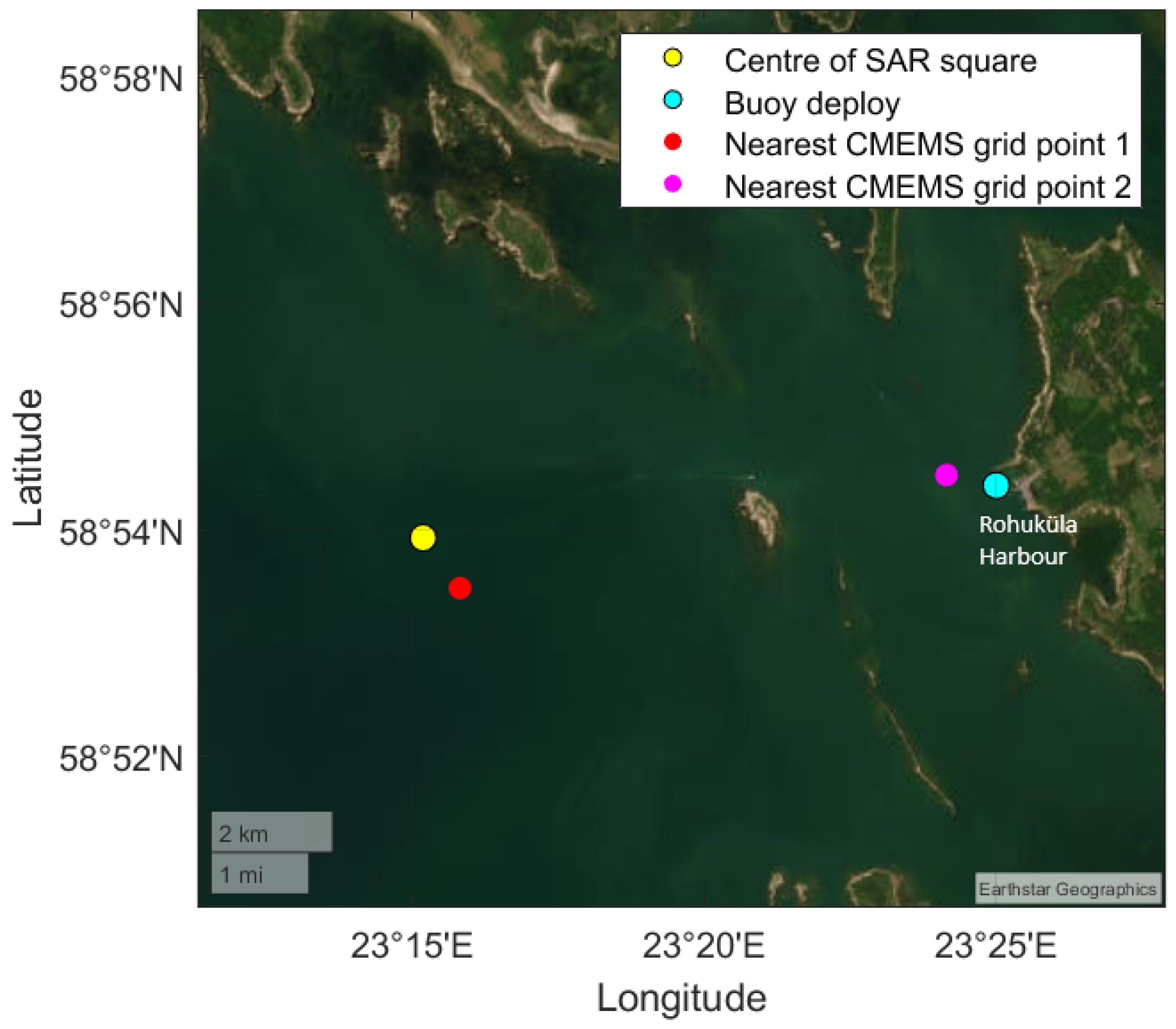
2. Materials and Methods
2.1. Measurements Data Preprocessing

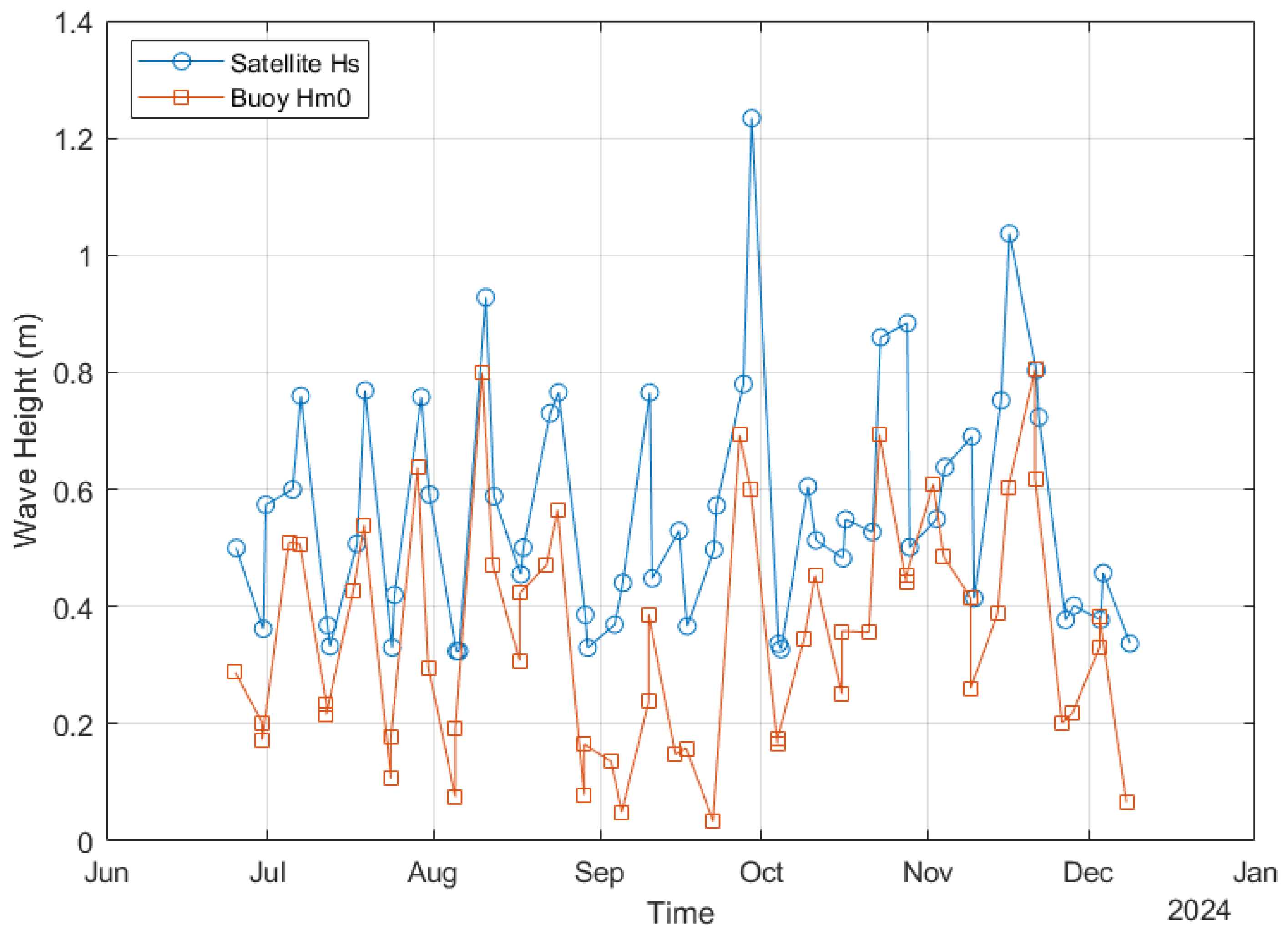
2.2. CMEMS Product Usage
2.3. Pairing Method for Satellite–Buoy Data Comparison
2.4. Wave Energy Calculation
3. Results
3.1. Wave Energy Conditions
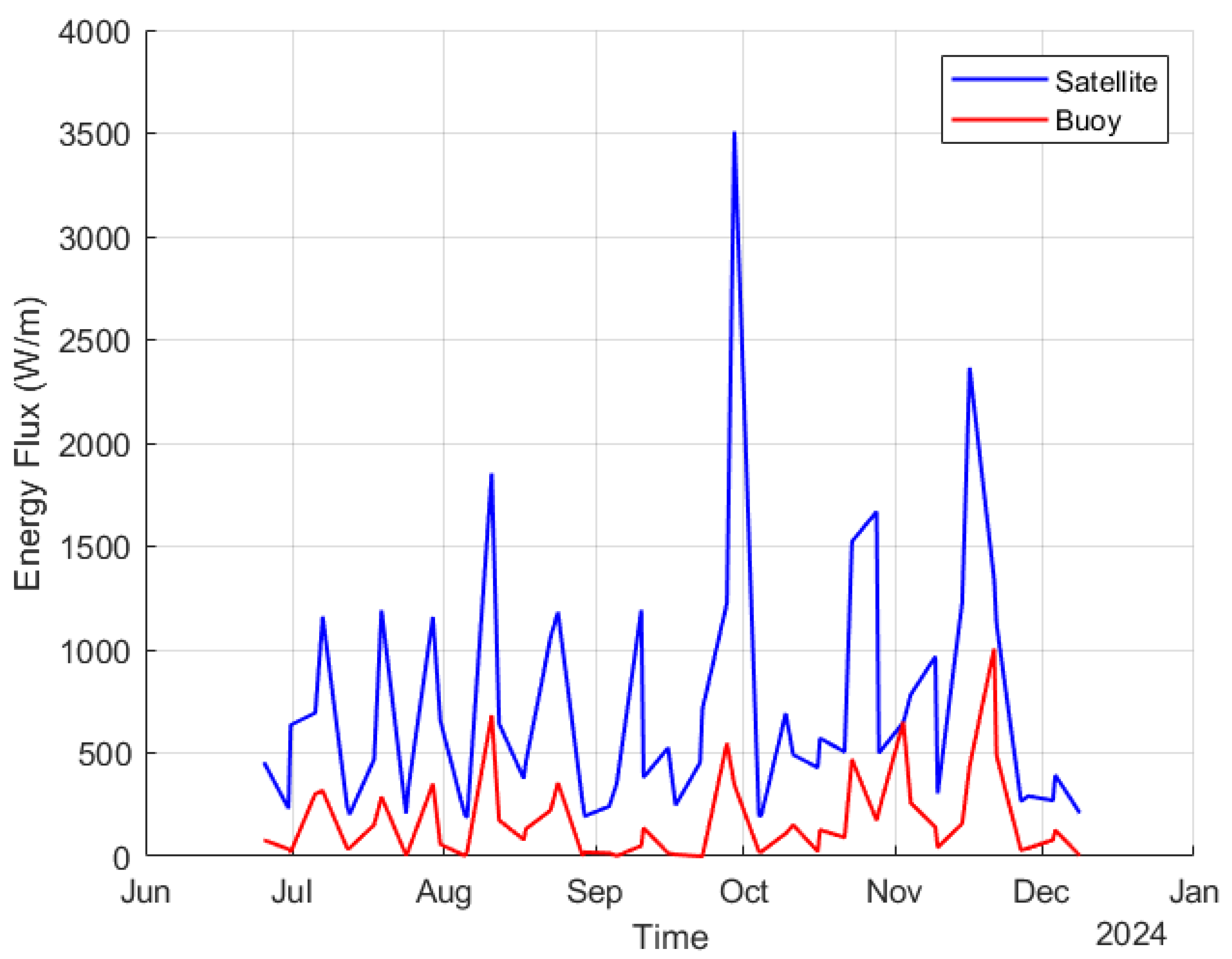
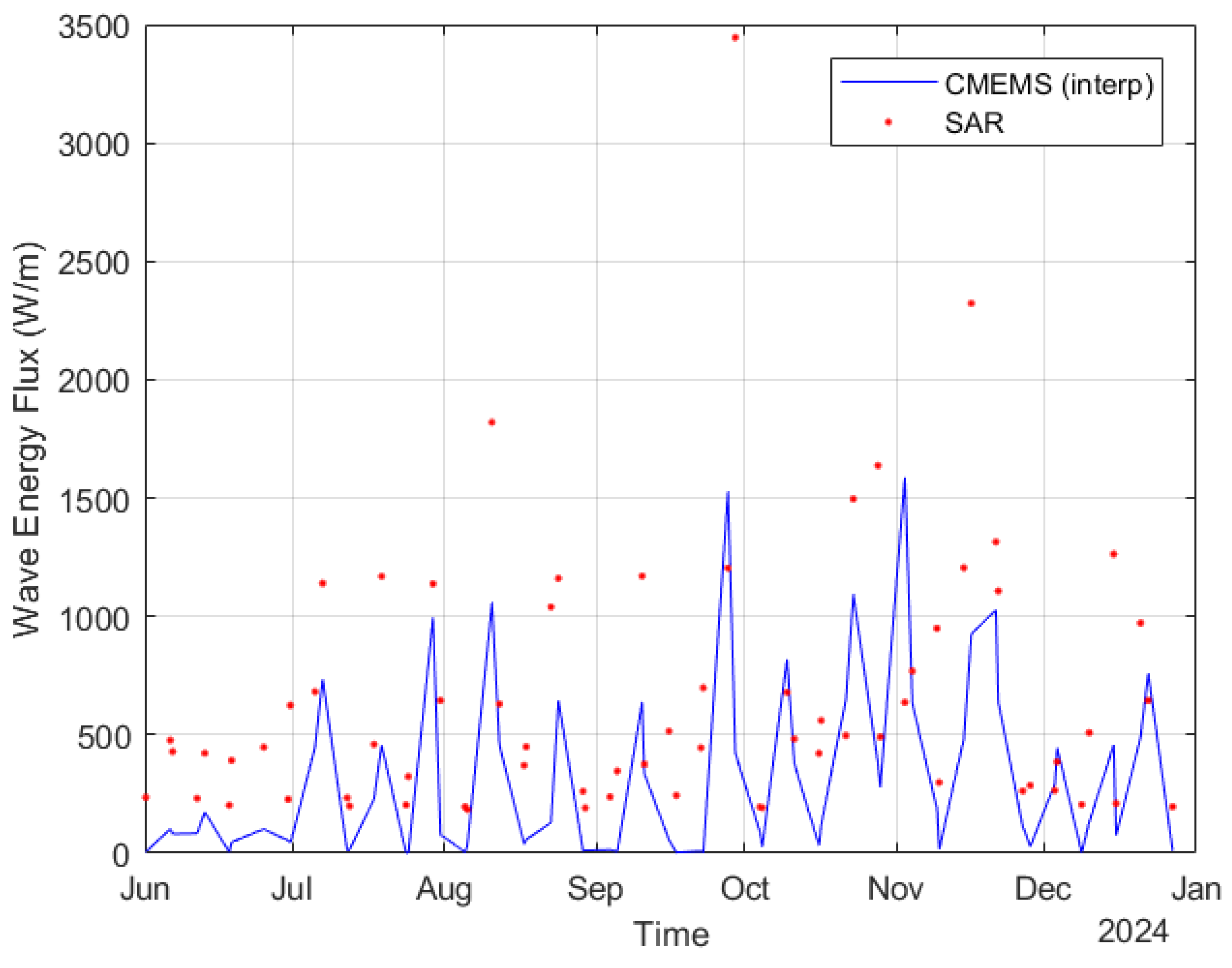
3.2. Satellite Spectra: LSTM and Sentinel-1
3.3. In Situ Spectra: LainePoiss Buoy
3.4. Spectral Comparison of C-Band SAR and Co-Located In-Situ Measurements
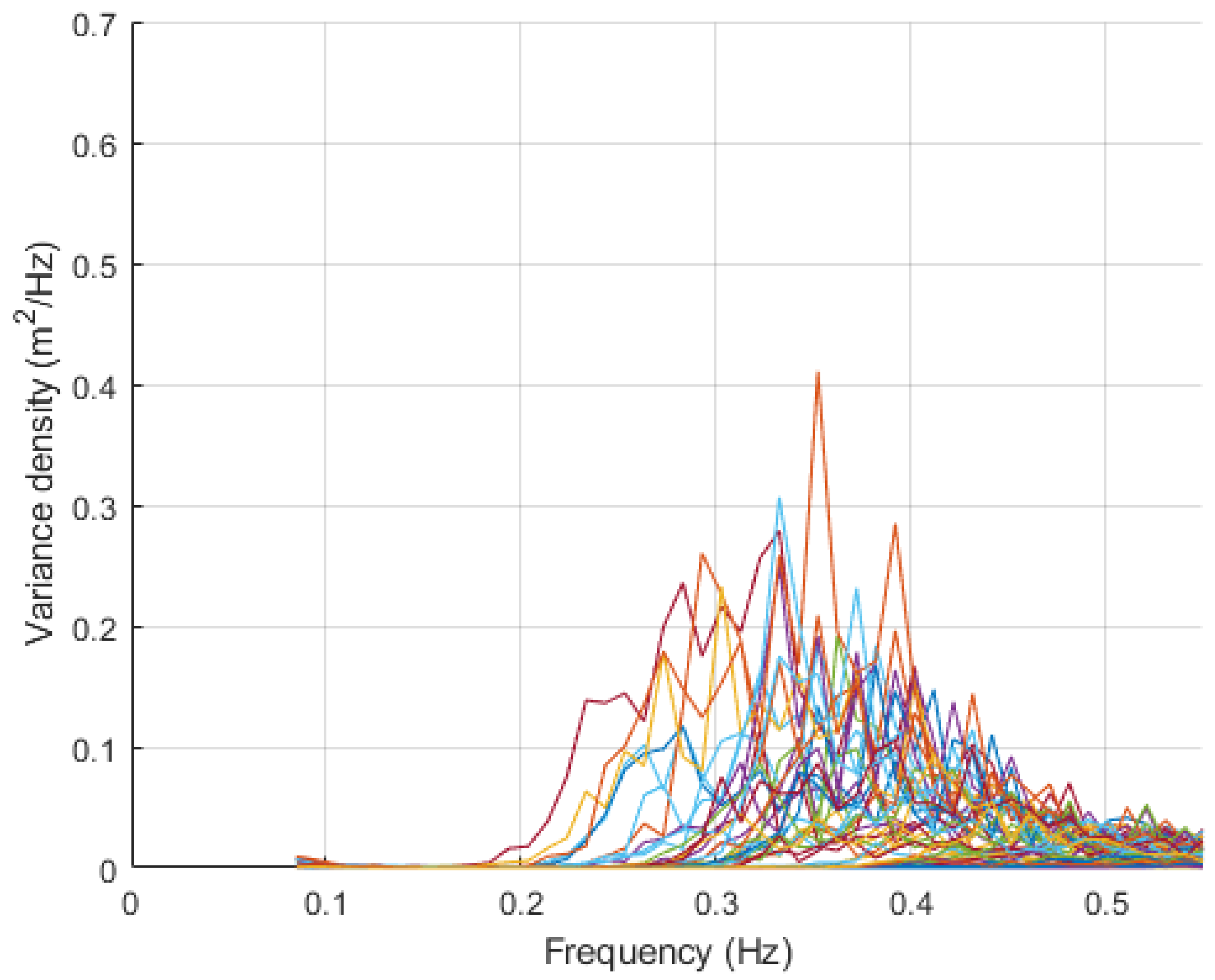
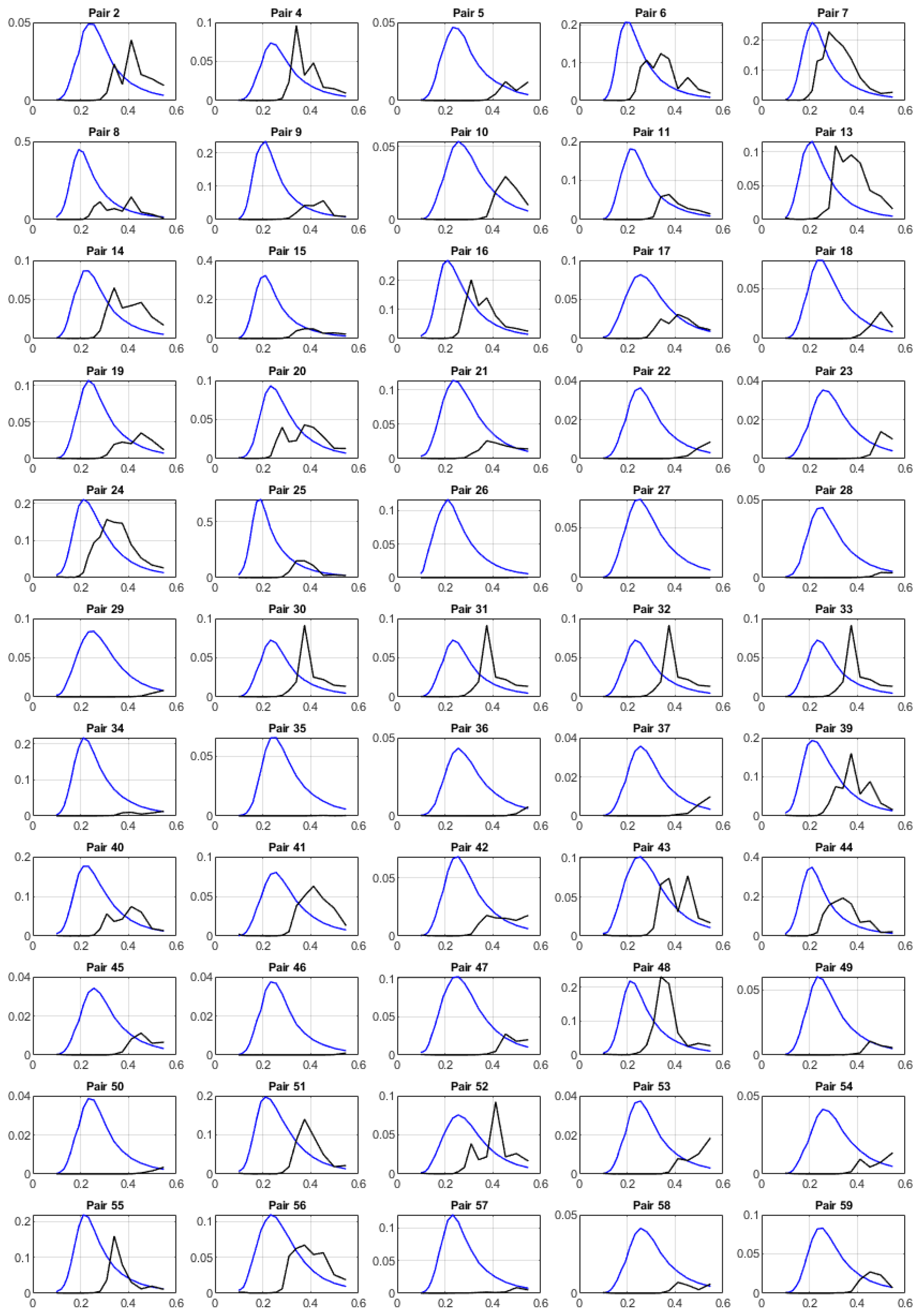
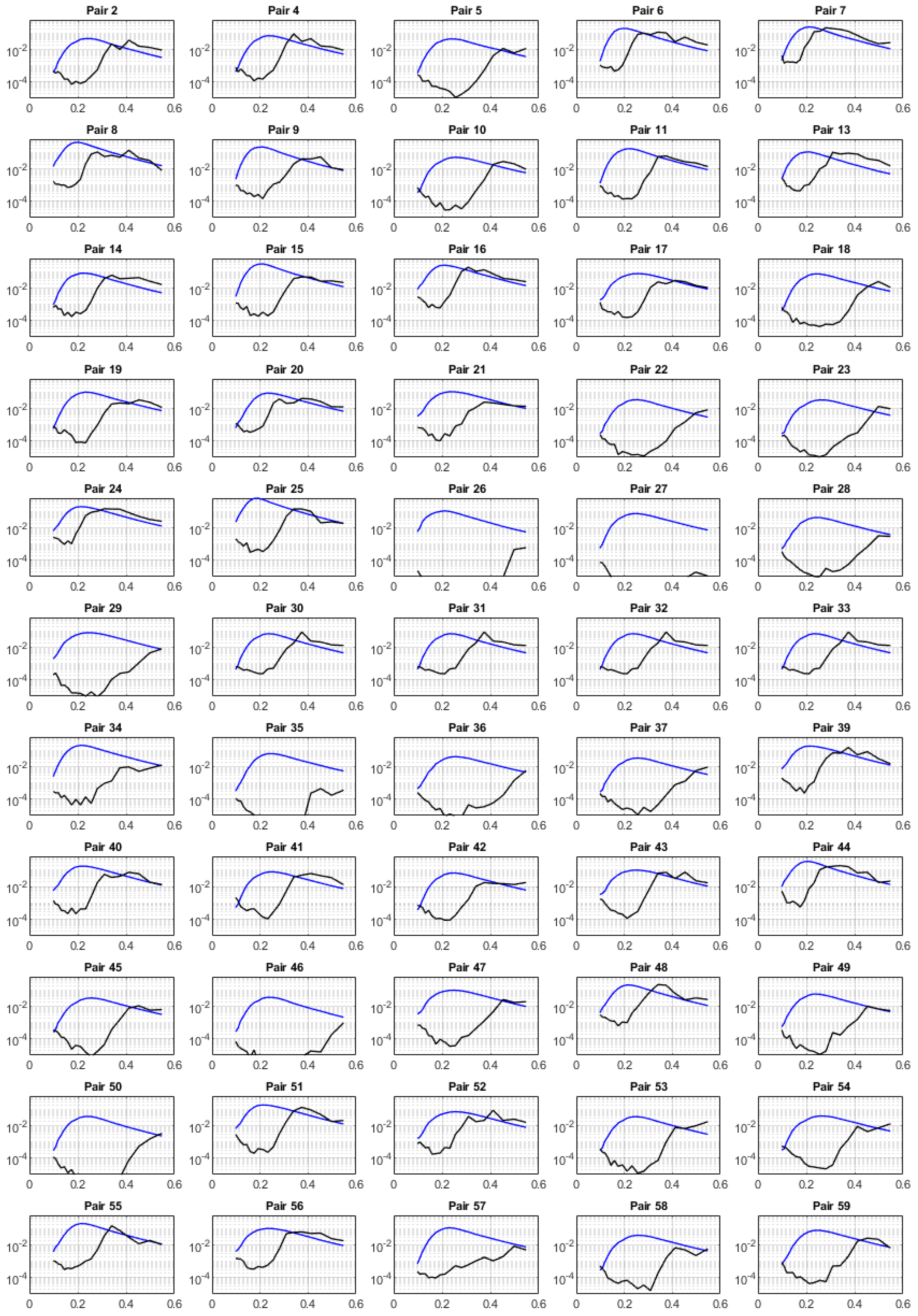
4. Discussion
4.1. Wave Energy Hotspot Definition and Site Evaluation
4.2. Satellite Derived Approach Validation and Key Limitation for Wave Energy Flux Prediction
4.3. Uncertainties, Limitations, and Future Directions
5. Conclusions
Author Contributions
Funding
Data Availability Statement
Acknowledgments
Conflicts of Interest
Appendix A. LSTM Method and SAR Limitations
Appendix A.1. LSTM Model Training and Data Collection

Appendix A.2. SAR Data Limitations
References
- Eurostat. Renewable Energy Statistics. 2025. Available online: https://ec.europa.eu/eurostat/statistics-explained/index.php?title=Renewable_energy_statistics (accessed on 1 March 2025).
- Robins, P.E.; Neill, S.P.; Lewis, M.J.; Ward, S.L. Characterising the spatial and temporal variability of the tidal-stream energy resource over the northwest European shelf seas. Appl. Energy 2015, 147, 510–522. [Google Scholar] [CrossRef]
- Clément, A.; McCullen, P.; Falcão, A.; Fiorentino, A.; Gardner, F.; Hammarlund, K.; Lemonis, G.; Lewis, T.; Nielsen, K.; Petroncini, S.; et al. Wave energy in Europe: Current status and perspectives. Renew. Sustain. Energy Rev. 2002, 6, 405–431. [Google Scholar] [CrossRef]
- Lebedeva, K.; Borodinecs, A.; Palcikovskis, A.; Wawerka, R.; Skandalos, N. Estimation of LCOE for PV electricity production in the Baltic States—Latvia, Lithuania and Estonia until 2050. Renew. Sustain. Energy Transit. 2025, 7, 100110. [Google Scholar] [CrossRef]
- Augutis, J.; Krikštolaitis, R.; Martišauskas, L.; Urbonienė, S.; Urbonas, R.; Ušpurienė, A.B. Analysis of energy security level in the Baltic States based on indicator approach. Energy 2020, 199, 117427. [Google Scholar] [CrossRef]
- Fang, S.; Jaffe, A.M.; Loch-Temzelides, T.; Lo Prete, C. Electricity grids and geopolitics: A game-theoretic analysis of the synchronization of the Baltic States’ electricity networks with Continental Europe. Energy Policy 2024, 188, 114068. [Google Scholar] [CrossRef]
- Laktuka, K.; Pakere, I.; Kalnbalkite, A.; Zlaugotne, B.; Blumberga, D. Renewable energy project implementation: Will the Baltic States catch up with the Nordic countries? Util. Policy 2023, 82, 101577. [Google Scholar] [CrossRef]
- Saha, P.; Kar, A.; Behera, R.R.; Pandey, A.; Chandrasekhar, P.; Kumar, A. Performance optimization of hybrid renewable energy system for small scale micro-grid. Mater. Today Proc. 2022, 63, 527–534. [Google Scholar] [CrossRef]
- Vidjajev, N.; Palu, R.; Terentjev, J.; Hilmola, O.P.; Alari, V. Assessment of the Development Limitations for Wave Energy Utilization in the Baltic Sea. Sustainability 2022, 14, 2832. [Google Scholar] [CrossRef]
- Soomere, T.; Eelsalu, M. On the wave energy potential along the eastern Baltic Sea coast. Renew. Energy 2014, 71, 221–233. [Google Scholar] [CrossRef]
- Kovaleva, O.; Eelsalu, M.; Soomere, T. Hot-spots of large wave energy resources in relatively sheltered sections of the Baltic Sea coast. Renew. Sustain. Energy Rev. 2017, 74, 424–437. [Google Scholar] [CrossRef]
- Sokolov, A.; Chubarenko, B. Baltic sea wave climate in 1979–2018: Numerical modelling results. Ocean Eng. 2024, 297, 117088. [Google Scholar] [CrossRef]
- Björkqvist, J.V.; Lukas, I.; Alari, V.; van Vledder, G.P.; Hulst, S.; Pettersson, H.; Behrens, A.; Männik, A. Comparing a 41-year model hindcast with decades of wave measurements from the Baltic Sea. Ocean Eng. 2018, 152, 57–71. [Google Scholar] [CrossRef]
- Samlas, O.; Luik, S.T.; Korabel, V.; She, J.; Lips, U. Applicability of Copernicus marine service products for the eutrophication status assessment of the Baltic Sea. Mar. Pollut. Bull. 2025, 216, 117975. [Google Scholar] [CrossRef] [PubMed]
- Pleskachevsky, A.; Tings, B.; Wiehle, S.; Imber, J.; Jacobsen, S. Multiparametric sea state fields from synthetic aperture radar for maritime situational awareness. Remote Sens. Environ. 2022, 280, 113200. [Google Scholar] [CrossRef]
- Alday, M.; Lavidas, G. The ECHOWAVE Hindcast: A 30-years high resolution database for wave energy applications in North Atlantic European waters. Renew. Energy 2024, 236, 121391. [Google Scholar] [CrossRef]
- Scala, P.; Manno, G.; Ingrassia, E.; Ciraolo, G. Combining Conv-LSTM and wind-wave data for enhanced sea wave forecasting in the Mediterranean Sea. Ocean Eng. 2025, 326, 120917. [Google Scholar] [CrossRef]
- Leng, S.; Shao, W.; Nunziata, F.; Migliaccio, M. An Algorithm for One-dimensional Wave Spectrum Retrieval from Gaofen-3 by Deep Learning. J. Atmos. Ocean. Technol. 2025, 42, 621–636. [Google Scholar] [CrossRef]
- Wu, K.; Li, X.M. Deep learning for retrieving omni-directional ocean wave spectra from spaceborne synthetic aperture radar. Remote Sens. Environ. 2024, 314, 114386. [Google Scholar] [CrossRef]
- Daniljuk, M.; Lastovko, I.; Rikka, S.; Nõmm, S. Statistical Machine Learning Techniques for Wave Spectre Estimation in Coastal Seas. In Recent Challenges in Intelligent Information and Database Systems, Proceedings of the 17th Asian Conference, ACIIDS 2025, Kitakyushu, Japan, 23–25 April 2025; Springer Nature: Singapore, 2025. [Google Scholar] [CrossRef]
- Tripathi, S.; Chapron, B.; Collard, F.; Guitton, G.; Lopez-Radcenco, M.; Mouche, A.; Fablet, R. Deep Learning Inversion of Ocean Wave Spectrum from SAR Satellite Observations. In Proceedings of the ICASSP 2024—2024 IEEE International Conference on Acoustics, Speech and Signal Processing (ICASSP), Seoul, Republic of Korea, 14–19 April 2024; pp. 8711–8715. [Google Scholar] [CrossRef]
- Alari, V.; Björkqvist, J.V.; Kaldvee, V.; Mölder, K.; Rikka, S.; Kask-Korb, A.; Vahter, K.; Pärt, S.; Vidjajev, N.; Tõnisson, H. LainePoiss(R)—A Lightweight and Ice-Resistant Wave Buoy. J. Atmos. Ocean. Technol. 2022, 39, 573–594. [Google Scholar] [CrossRef]
- Rikka, S.; Nõmm, S.; Alari, V.; Simon, M.; Björkqvist, J.V. Wave Density Spectra Estimation with LSTM from Sentinel-1 SAR in the Baltic Sea. In Proceedings of the IEEE/OES Thirteenth Current, Waves and Turbulence Measurement (CWTM), Wanchese, NC, USA, 18–20 March 2024; pp. 1–5. [Google Scholar] [CrossRef]
- E.U. Copernicus Marine Service Information (CMEMS). Marine Data Store (MDS); In Baltic Sea Wave Hindcast; Finnish Meteorological Institute (FMI): Helsinki, Finland, 2025. [Google Scholar] [CrossRef]
- O’Connell, R.; de Montera, L.; Peters, J.L.; Horion, S. An updated assessment of Ireland’s wave energy resource using satellite data assimilation and a revised wave period ratio. Renew. Energy 2020, 160, 1431–1444. [Google Scholar] [CrossRef]
- Leppäranta, M.; Myrberg, K. Physical Oceanography of the Baltic Sea, 1st ed.; Springer Praxis Books; Springer: Berlin/Heidelberg, Germany, 2009; 378p. [Google Scholar] [CrossRef]
- Vakili, A.; Pourzangbar, A.; Ettefagh, M.M.; Abdollahi Haghghi, M. Optimal control strategy for enhancing energy efficiency of Pelamis wave energy converter: A Simulink-based simulation approach. Renew. Energy Focus 2025, 53, 100685. [Google Scholar] [CrossRef]
- Pleskachevsky, A.; Jacobsen, S.; Tings, B.; Schwarz, E. Estimation of sea state from Sentinel-1 Synthetic aperture radar imagery for maritime situation awareness. Int. J. Remote Sens. 2019, 40, 4104–4142. [Google Scholar] [CrossRef]
- Li, X.M.; Huang, B. A global sea state dataset from spaceborne synthetic aperture radar wave mode data. Sci. Data 2020, 7, 261. [Google Scholar] [CrossRef] [PubMed]

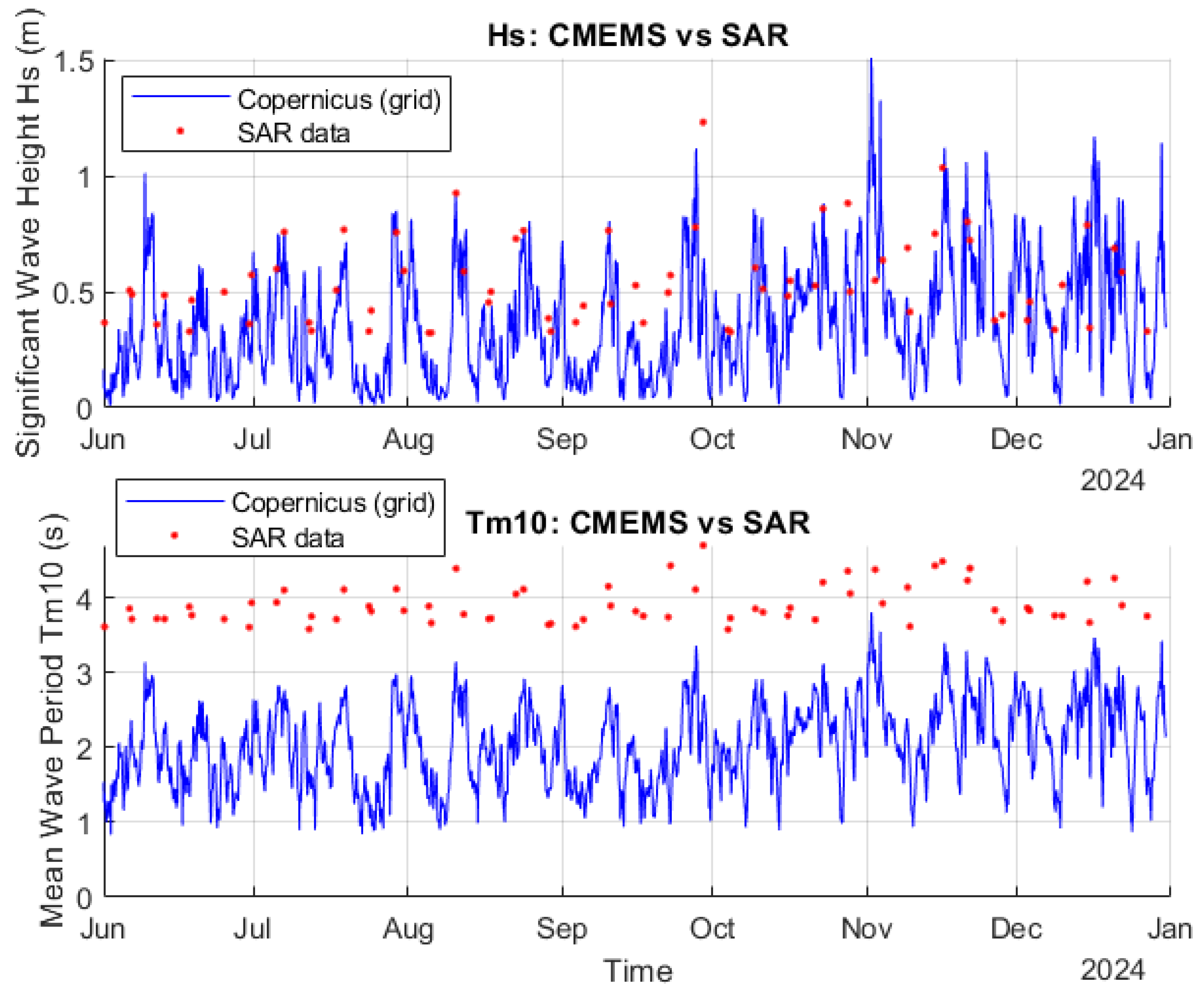

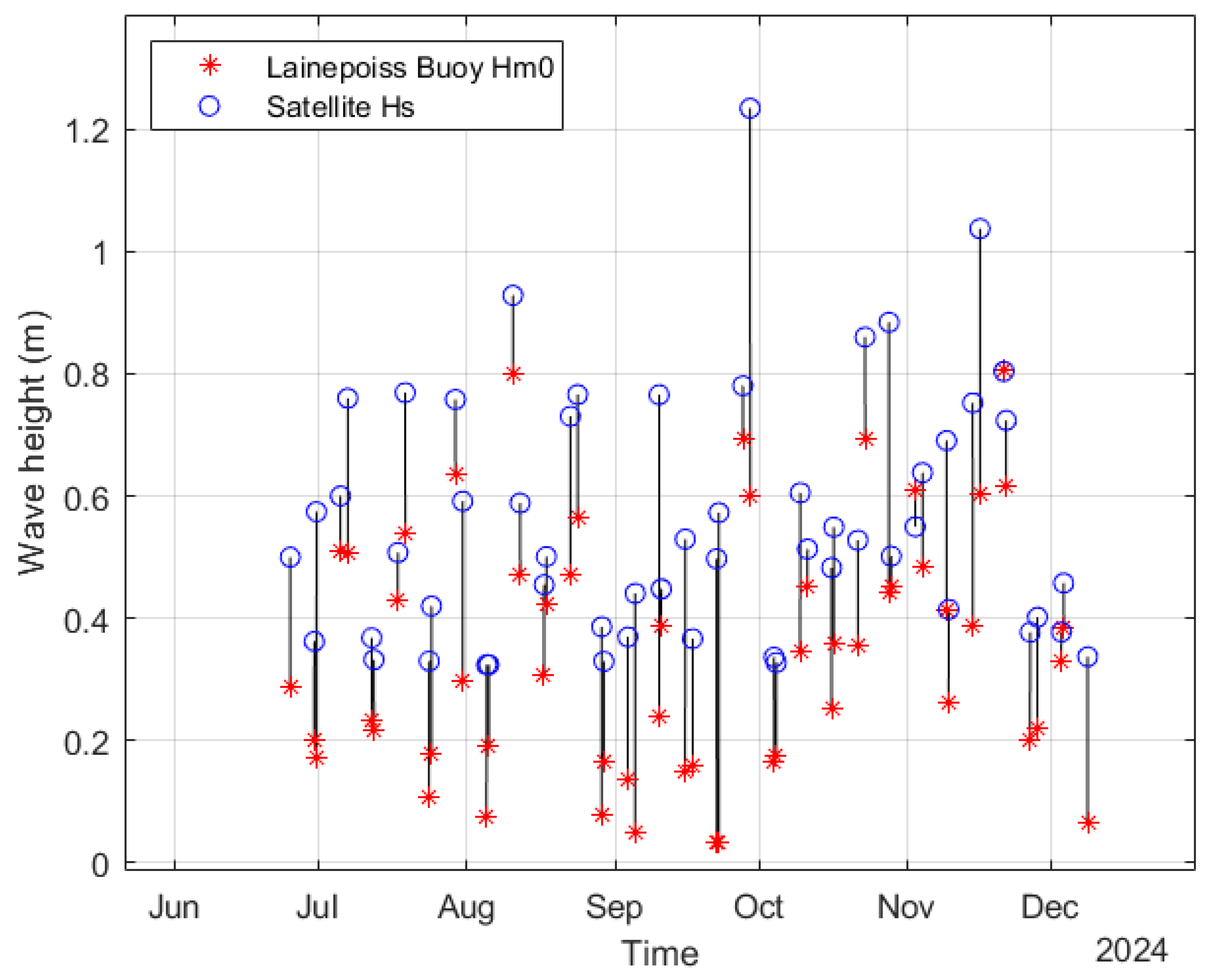
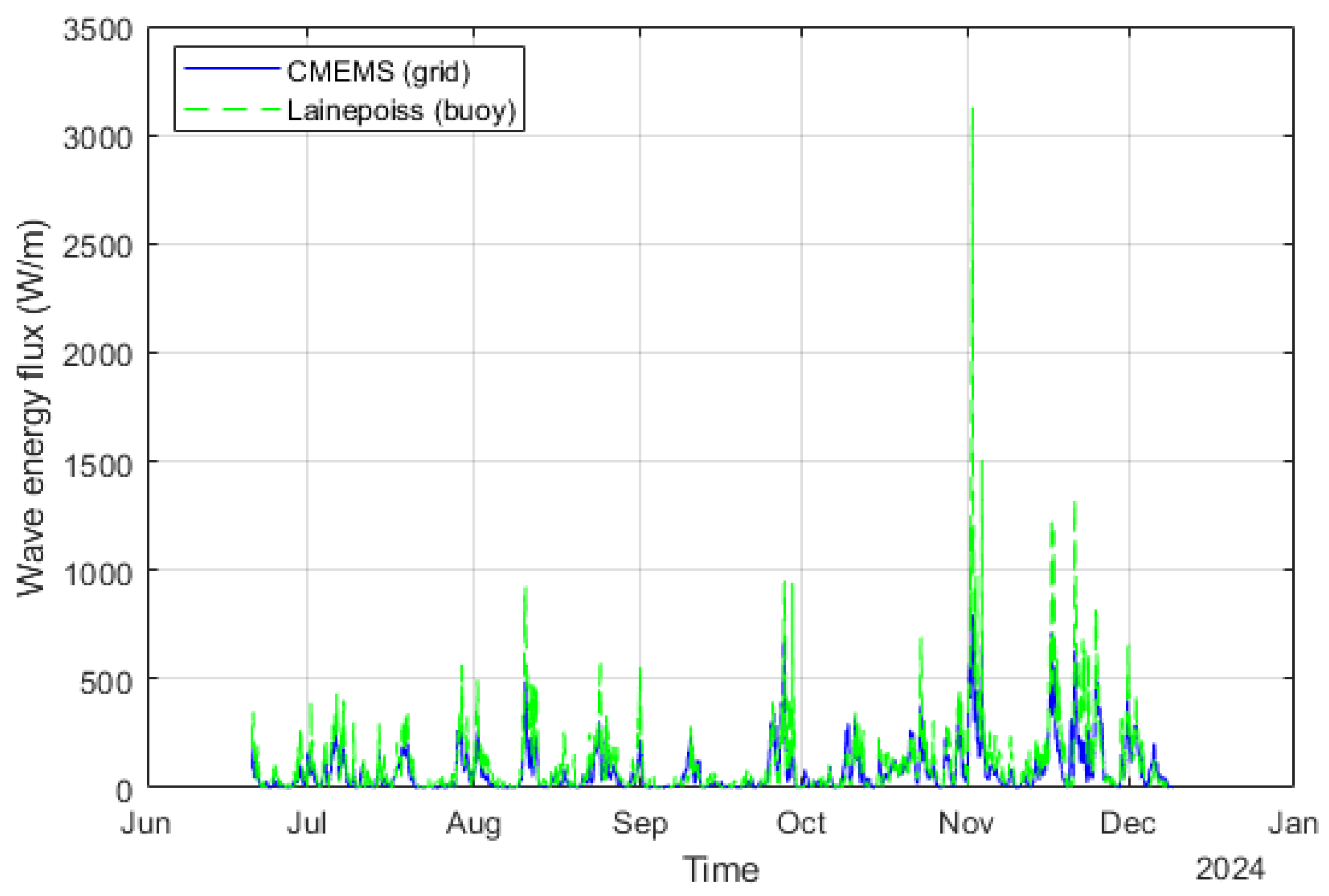

Disclaimer/Publisher’s Note: The statements, opinions and data contained in all publications are solely those of the individual author(s) and contributor(s) and not of MDPI and/or the editor(s). MDPI and/or the editor(s) disclaim responsibility for any injury to people or property resulting from any ideas, methods, instructions or products referred to in the content. |
© 2025 by the authors. Licensee MDPI, Basel, Switzerland. This article is an open access article distributed under the terms and conditions of the Creative Commons Attribution (CC BY) license (https://creativecommons.org/licenses/by/4.0/).
Share and Cite
Vidjajev, N.; Rikka, S.; Alari, V. Pre-Evaluation of Wave Energy Converter Deployment in the Baltic Sea Through Site Limitations Using CMEMS Hindcast, Sentinel-1, and Wave Buoy Data. Energies 2025, 18, 3843. https://doi.org/10.3390/en18143843
Vidjajev N, Rikka S, Alari V. Pre-Evaluation of Wave Energy Converter Deployment in the Baltic Sea Through Site Limitations Using CMEMS Hindcast, Sentinel-1, and Wave Buoy Data. Energies. 2025; 18(14):3843. https://doi.org/10.3390/en18143843
Chicago/Turabian StyleVidjajev, Nikon, Sander Rikka, and Victor Alari. 2025. "Pre-Evaluation of Wave Energy Converter Deployment in the Baltic Sea Through Site Limitations Using CMEMS Hindcast, Sentinel-1, and Wave Buoy Data" Energies 18, no. 14: 3843. https://doi.org/10.3390/en18143843
APA StyleVidjajev, N., Rikka, S., & Alari, V. (2025). Pre-Evaluation of Wave Energy Converter Deployment in the Baltic Sea Through Site Limitations Using CMEMS Hindcast, Sentinel-1, and Wave Buoy Data. Energies, 18(14), 3843. https://doi.org/10.3390/en18143843






